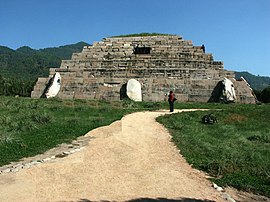Capital Cities and Tombs of the Ancient Koguryo Kingdom
| UNESCO World Heritage Site | |
|---|---|
 The Tomb of the General within the site | |
| Criteria | Cultural: i, ii, iii, iv, v |
| Reference | 1135 |
| Inscription | 2004 (28th Session) |

Capital Cities and Tombs of the Ancient Koguryo Kingdom is a UNESCO World Heritage Site located in and around the city of Ji'an in China. Koguryo (or Goguryeo, 37 BCE – 668 CE) was an ancient kingdom located in what is now Northeast China and the northern Korean Peninsula.
The site was designated a cultural World Heritage Site in 2004, qualifying as such under the first five of the six criteria for cultural heritage sites.[1]
The site contains the archaeological remains of three fortress-cities: Wunü Mountain City, Gungnae City and Wandu Mountain City) and forty identified tombs of Goguryeo imperial and noble families.[1]
Capital cities
Wunü Mountain City (Onyeosanseong) was the first capital of Goguryeo. Guonei (Gungnae) City and Wandu Mountain City (Hwando) were also capitals of the Goguryeo.[1] These areas are now in China but were historically in Goguryeo territory, a proto-Korean kingdom.
Onyeosanseong is only partly excavated. Gungnae City, within the modern city of Ji'an, played the role of a supporting capital after the main Goguryeo capital moved to Pyongyang. Wandu Mountain City contains many vestiges including a large palace and many tombs.[1]
The capital cities of the Goguryeo are an early example of mountain cities later imitated by neighbouring cultures. The system of capital cities represented by Gungnae City and Wandu Mountain City also influenced the construction of later capitals built by the Goguryeo regime.[1]
The capital cities of the Goguryeo represent a perfect blending of human creation and nature whether with the rocks or with forests and rivers.[1]
Tombs
The site includes archaeological remains of 40 tombs which were built by Goguryeo, which was founded by Jumong in a region called Jolbon Buyeo, thought to be located in the middle Yalu and Tongjia River basin, overlapping the current China-North Korea border.
Some of the tombs have elaborate ceilings designed to roof wide spaces without columns and carry the heavy load of a stone or earth tumulus (mound) was placed above them. The paintings in the tombs, while showing artistic skills and specific style, are also an example of strong influence from various cultures.[1]
The tombs represent a masterpiece of the human creative genius in their wall paintings and structures.[1]
Since these are the tombs of the kings of Goguryeo, these tombs are widely recognized as the Heritage of Korea.
See also
- Complex of Goguryeo Tombs, UNESCO world heritage site in Pyongyang, North Korea.
- Ancient Tombs at Longtou Mountain with Mausoleum of Princess Jeonghyo of Balhae.

